Frank Raymond Wilton ‘Lofty’ England
From Apprentice, Race Engineer, Team Manager, Service Manager to Chairman and Chief Executive
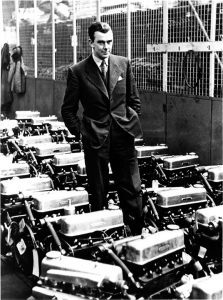
1946 Lofty England
amidst Standard Engines
Lofty England started his working life as an apprentice for Daimler before going into racing as a driver and then a race engineer. He saw service in the RAF as a bomber pilot and training instructor, joining Jaguar after the war, as service manager and running the Company’s racing programme in the 1950s. He rose through the ranks succeeding William Lyons as chairman and Chief Executive in 1972.
Frank Raymond Wilton England stood 6 ft 5 ins (2 m), so it was only natural that he was universally known as Lofty. Although, given the perverse nature of English humour, he could equally have been called ‘Titch’!
However, it was as Lofty that this quiet man was referred to.
England was born in East Finchley, North London, on 24 August 1911, and was educated in Bristol and Christ’s College, Finchley. From an early age he showed an interest in cars, and when the family moved to Edgware, Middlesex, he was surrounded by motor car manufacturers and service agents.
England wrote to Bentley Motors, in nearby Cricklewood, asking about an apprenticeship but there were no vacancies, so he applied to Daimler, who had service premises in Edgware. His application was successful and he joined them in 1927.
Working Mechanic
Apart from learning the intricacies of the internal combustion engine and all that went to make up a car, he also developed a taste for speed. He drove one of Laurence Pomeroy’s Daimler Double Sixes into second place in the 1932 RAC Rally. After he completed his five-year apprenticeship at Daimler he looked elsewhere for a possible opening in racing. As Lofty was often at the Brooklands track in Surrey, it was not long before his services were sought. The famous pre-war racing driver Sir Henry Tim Birkin asked Lofty to join his new Bentley team that had been formed after the demise of Bentley Motors in 1931, as an independent company – Birkin and Couper. Later, Lofty recalled those days, “We prepared the Bentleys and other customer cars, including Lord Howe’s Alfa. We also did some customer car service and we built a modern tractor. Tractors in those days did not have rubber tyres, they had spiked wheels. Sir Henry Birkin decided to use Zoller super-chargers for the rear wheels and so we built one of the first-ever modern tractors. We also did a motor racing game developed for fairgrounds, but this caused the Company financial problems.”
Birkin and Couper ceased trading and Lofty joined Alvis as a fitter at their service depot in Jubilee Place, Chelsea, London. However, it was not long before he was headhunted (to use a modern term), in 1934, by the wealthy American sportsman Witney Straight to work on his Maserati stable. Lofty moved to Milan and worked under the great Italian engineer Giuilio Ramponi. Lofty later recalled that, “We looked after the Maseratis in a house and Garage in the Via California. It was totally destroyed by the Americans when they were bombing Rome.” However, at the end of the season, Lofty joined ERA (English Racing Automobiles) for a few months and then returned to Alvis. In December he re-joined ERA and their new driver Marcel Lehoux. Sadly, Lehoux was killed in July 1936 and Lofty found the team, under Raymond Mays, not to his liking. Leaving at the end of the season in September he joined the legendary Richard Dick Seaman as chief mechanic. Lofty regarded Seaman as, “Undoubtedly the most courageous and best British driver of the pre-war days.” When Seaman left to race his famous Delage in South Africa, Lofty accompanied him. This too was short-lived, as Seaman was hired to drive for Mercedes-Benz and there was no place for Lofty as an engineer with the German team. Lofty was not out of work long as he was quickly snapped up by the White Mouse Garage, run by Prince Chula of Siam for his nephew Prince Bira.
Bira’s stable – which Lofty considered was the only house in Britain that was run on an efficient basis – consisted of two ERAs, an ex-Straight Maserati 3.3-litre, the ex-Seaman Delage and a Delahaye sports car. It was 1937 and Lofty was 26-years-old. He had already raced his Rudge Python, engined, Cotton, motorcycle to second place in the Manx Motorcycle Grand Prix the year before and seemed content in the fast lane. His task for White Mouse was to prepare the cars for racing and then test drive them at Brooklands or drive them to the practice venue. While he enjoyed this work it was not permanent, so, in 1938, he applied to Alvis once again. Lofty was accepted and moved to their factory in Coventry as a Service Engineer, but was soon appointed Superintendent of the works Service Department.
Wartime Service
The future hardly looked secure after 3 September 1939, when Britain declared war on Germany. Lofty was keen to do his bit, but as a reserved occupation he was kept on at Alvis on vital war work, servicing Rolls-Royce aircraft engines. However, he was able to obtain his release in 1941 and joined the Royal Air Force. Selected for pilot training he was sent to the United States for flying instruction. He was obviously a ‘natural’ pilot qualifying as a bomber pilot, probably too tall to pilot fighters. He was seconded to the United States Army Air Force as an instructor, not too much to his liking as he wanted to get back to Britain and into action. After several requests Lofty was posted back to the UK, in 1943, to Bomber Command and Avro Lancasters with No. 514 Squadron at RAF Waterbeach in Cambridgeshire. Lofty later wrote, ‘We flew radar directed strategic bombing raids in daylight on Germany, mainly on small targets such as synthetic oil plants, and sometimes operating a mile or so in front of the advancing troops.’
Lofty England was demobilised in 1945 and returned to Alvis as Assistant Service Manager. The following year he drove an Alvis Special 12/70 in the Brussels Grand Prix, finishing sixth – and a few months later he drove the same car in Ireland, but retired early. He was unhappy at Alvis, as there appeared to be no possibility of promotion. However, a contact from his Brooklands days, Walter ‘Wally’ Hassan mentioned that the Service Manager at Jaguar Cars was leaving and that Lofty should apply for the post. Hassan, who had returned to Jaguar after a spell at Bristol Aero engines, also recommended Lofty to Jaguar Managing Director William Lyons.
Jaguar Years
Lofty’s application was successful and he joined Jaguar Cars at Swallow Road, Foleshill, in September 1946 as Service Manager. His many other roles of Racing Manager, Exhibitions Manager etc. were all ‘additional and incidental!’ He later said, “I think coming into this Company at the time I did was a bit of luck really, because we had a very limited number of people in senior positions, and the net result of all this was that, apart from being Service Manager, you did a lot of other things at the same time because there weren’t other people to do them.”
As we have noted, Lofty had other duties, including travelling with Jaguar PR officer, E.W. Bill Rankin. Together they would travel to various international motor shows, set up the stands and sell the cars. Thus, they met many of Jaguar’s overseas owners face-to-face. When Lofty joined Jaguar, Lyons had told him that motor sport was not something that the Company wanted to get involved in. Lyons had seen other successful manufacturers lose money by putting racing high on the agenda, he was shrewd enough to realise that enthusiastic investment in racing was not the way forward. At the same time Jaguar was committed to offer technical advice and assistance to private owners, but that was the limit of their involvement.
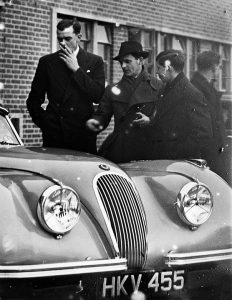
1949 Lofty with HKV 455
The First XK120
Raced by Prince Bira
However, circumstances forced a change of policy; in 1948 Jaguar had produced the XK engine, the first that they had designed in-house and interest in the unit was high. When the XK120 was driven by Ron Soapy Sutton at Jabbeke at 132 mph (212 km.hr) the publicity, engineered by Rankin, was tremendous and there was pressure on Jaguar to take the XK120 into competitive motor sport. Then in 1949 the Daily Express sponsored the production sports car race at Silverstone. Lofty recalls, “We had to decide whether to enter: it wasn’t easy as we were expected to win. If we did no one would expect anything else and we certainly could not afford to lose. We entered three cars for Johnson, Bira and Peter Walker, and they came home first and second, although Bira retired. So we now became involved in motor racing, and it developed from that point. Again we made use of the people we had already, which was how I became involved. It was a sort of spare time job.”
In reality it was more than a spare time job, but one that Lofty was ideally suited for and one that he clearly revelled in. He was the Jaguar Team Manager, and as such was responsible for the races they entered, hiring the drivers and making all the travel arrangements. He used to attend all the test sessions after the cars had been built, at first in the experimental department, but later in Jaguar’s own competition department.
Lofty England had the overall responsibility for the entire operation and ran it in a relaxed but very efficient manner. He would tell his drivers to be at the race circuit on a specified date and time and they would duly appear.
Le Mans
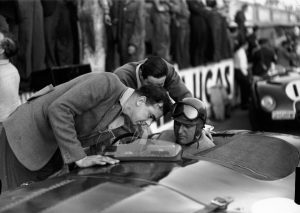
1951 Le Mans, Lofty England, Duncan Hamilton and Tony Rolt
Leslie Johnson won major sports car races in Britain and America in 1950 and took fifth in the 1950 Mille Miglia, the Jaguar beaten only by works Ferraris and Alfa Romeos. Lofty: “In 1950 we had three private XK120s in the race – for Johnson / Hadley, Whitehead / Marshall and Haines / Clark. They were virtually standard cars racing against thinly disguised Grand Prix cars, Talbots and so on.” Besides these there were virtually no modern sports cars, and Johnson and Hadley ran as high as second before mechanical failure forced them out when lying third near the end, while the other XK120s finished 12th and 15th.
Lofty “So we decided to design a proper aerodynamic body for the 1951 Le Mans. We decided to win Le Mans in June 1951!” Three C-types were driven to Le Mans accompanied by a Bedford support lorry and a team car. “Only one of the three cars finished, but it won!” Jaguar had won Le Mans for the first time and that single car made Jaguar an international household name.
Jaguar entered C-types for the 1952 Le Mans but modifications made to the bodywork caused overheating and all three works cars failed before an hour had elapsed. In 1952 Lofty England and several factory mechanics supported a high-speed endurance run at Linas-Montlhéry, where Johnson, Moss, Hadley and Jack Fairman drove a works-modified XK120 coupé LWK 707, the personal car of William Heynes, at an average of just over 100 mph for seven days and nights to break nine speed and endurance records.
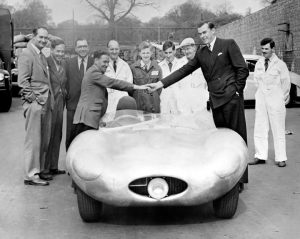
1954 Norman Dewis shakes hands with Lofty England over D-type prototype
Jaguar went on to win Le Mans five times with the C-type and D-type. While Lofty was still in evidence heading the team, the department had grown and was largely under Phil Weaver. Jaguar left Le Mans while they were still competitive. Lofty later explained, “By 1956 we needed to be sure of winning and to do so we had to update the D-type. So we decided to pull out for a year and develop a potential winner based on the E-Type prototype which was running in 1956. But then in 1957 we had the great fire at the factory, and all our efforts were put into the factory rebirth. Sales were going very well, we needed every production car we could make, and there was just no real need to carry on racing. We continued to support people like Ecurie Ecosse and Duncan Hamilton. Later we did the Cunningham car [E2A] as a project for Le Mans in 1960, and we developed the lightweight E-Type from it.”
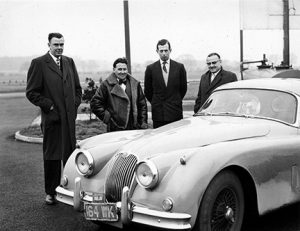
1957 Lofty England, Norman Dewis, the Duke of Kent and William Heynes
Following Jaguar’s withdrawal from racing Lofty returned to his main role running the company’s service department, now as Director.
In 1958, Guy Vandervell offered Lofty the entire Vanwall F1 team following the death of Stuart Lewis-Evans during the 1958 Moroccan Grand Prix. If Lofty was tempted we do not know; in the event he refused the very handsome offer and stayed with Jaguar. He would have made an excellent team manager.
Work Continues
Lofty England was modest about his role in the factory fire. In fact, like so many, he was on the site directing operations to save cars from burning buildings. Quick thinking by Lofty, Lyons and others, along with the quick work by the fire-fighting teams, probably saved Browns Lane from greater disaster. He was closely involved with Lyons and the rebuilding plans to get Jaguar back into production. There was no time for competition work, although he continued to take an interest and send memos to his boss about a return to the race track during the 1960s.
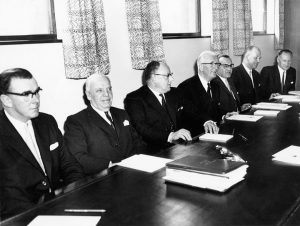
1961 Jaguar Board Meeting: Lofty England, Edward Huckvale, Arthur Whittaker, Sir William Lyons, William Heynes, John Silver
and Bob Grice
When Jaguar bought Daimler in 1960, Lofty was given the responsibility for the bus and fighting vehicle divisions. He clearly enjoyed this different aspect of the motor industry. Quite a contrast between those racing cars of pre-war years and Le Mans and heavy vehicles. In 1961 Jaguar had added Guy Motors to the group and Lofty was appointed Assistant Managing Director. He and Lyons made an excellent team; they understood and respected each other.
Lofty recalled his early days at Jaguar in his usual wry manner. “He (Lyons) was a very good leader. There was always opportunity to go forward working under him. He had first-rate, clear-cut ideas and he told you exactly what your responsibilities were. After I had joined Jaguar, I had been there for about six months and I had not heard a word from him as to how I was doing. So I went to see him and I said, ‘How am I getting on?’ and he just turned round and said he’d tell me when I was going wrong!”
Lofty relished running the Service Department at Jaguar. It was what he knew best and also brought him into contact with people from all walks of life. Apart from the customers, he dealt with suppliers, dealers and agents, not only in the UK but also on a global basis. During his early years he used to travel far more extensively, often with Bill Rankin, and over the years he maintained the contacts he had made during those travels.
As Jaguar grew in stature and strength, Lofty advanced with it. He was involved on a daily basis with the running of the enterprise, and when he was made Assistant Managing Director his workload grew as a consequence. However, he took it in his stride and made the ideal deputy boss. Lyons relied greatly on his key players, such as Heynes, Knight and Lofty. Of course Lyons’s word was still the only one that counted, but as Jaguar was no longer a small business, the wisdom of others had to be considered.
Jaguar Merges
In 1966, Sir William Lyons merged Jaguar with the British Motor Corporation (BMC) to form British Motor Holdings (BMH). (See the Sir William Lyons profile for a more detailed account of the merger). As Lyons’s assistant, Lofty was on the frontline and was appointed Joint Managing Director with R. W. (Bob) Grice. Two years later BMH was taken over by Leyland Motors to form British Leyland (BL) and Grice and Lofty were made Joint Managing Directors with Sir William as Chairman and Chief Executive.
The alliance with BL was an uneasy one. Lyons and his team fought hard to keep Jaguar independent, but the sheer size of BL made the ride a bumpy one. However, largely due to the efforts of Lofty and Bob Knight, Jaguar kept its independence.
During the BL days Lofty commented: “Jaguar is at the top of the British Leyland range, it doesn’t overlap with anything else. If you want a car to retain its individuality, then it has to be something produced by individuals whose job is that and that alone, and you have got to have people whose life has been steeped in the Jaguar image. Otherwise, if you bring in someone in from the outside you start to produce something entirely different, and in a very short period of time you lose that image.”
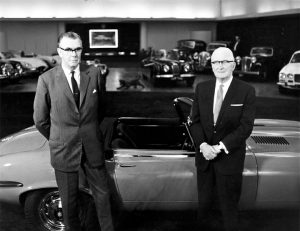
1972 Lofty England and
Sir William Lyons
in front of the V12 Series 3 E-type
In between the management upheaval, Lofty England invited back old friend Walter Hassan to develop Jaguar’s V12 engine. The engine made its debut in the Series 3 version of the E-Type in 1971, one year before Lofty England succeeded William Lyons as chairman and Chief Executive of Jaguar Cars. It was during his time as CEO that Lofty had to negotiate with the unions to ensure that the car the V12 was built for, the V12 version of the Jaguar XJ saloon, was not delayed into production. Reflecting his own previous success and the Daimler company history, Lofty decided that the Daimler version of the V12 should be called the Double Six.
In 1972 Sir William Lyons retired from Jaguar Cars and Lofty, aged 60, was appointed in his place. Soon afterwards BL announced that the group would be known as British Leyland UK Limited and Jaguar Cars would cease to be a separate company. At Jaguar they thought otherwise and the switchboard never answered the telephone as “British Leyland”, it was always “Jaguar Cars”. This probably irritated the corporate types, but delighted the Jaguar workforce and it helped retain their identity, which was certainly in jeopardy.
Under Lofty, Jaguar continued on its way, but there was little investment from the parent BL. A note from Lofty to a journalist during this time reads (in part), ‘We have some very good engineers who produce outstanding motor cars. Our future plans in my opinion ensure the prosperity of this company for a very long time for what we have to offer in the future will, I am sure, be as attractive as anything we have built in the past, if not more so. We really ought to be going places, but how quickly we go depends on being able to meet our production targets and increasing production in order to make the money we need for future developments.’
Retirement
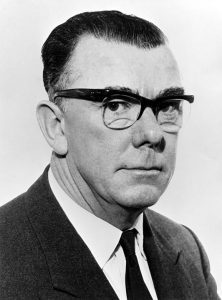
Lofty England
With increasing industrial tensions and centralised decision making within British Leyland, Lofty felt that his position was untenable and, aged 63, he retired to Austria in 1974, but he did not disappear from the scene. In retirement he was a tireless ambassador for Jaguar and was to be seen on a regular basis anywhere that the cars were gathered; club events, sporting venues or new product launches.
Lofty became a consultant to Reliant Motor Company of Tamworth, Staffordshire, UK and helped Reliant to appoint importers and distributors for its Scimitar GTE sports estate car in Austria, Belgium, the Netherlands and Switzerland.
He was as much delighted as Sir William was when John Egan took over Jaguar and brought it back from the edge of the precipice. Jaguar’s renaissance was watched with great interest by Lofty from his retirement home in Austria, the native country of his wife Doris.
Lofty England died in Austria on 30 May 1995 aged 83. His legacy continues to the present day, as he was one of the very few key people that Lyons trusted to head the business that he had founded in Blackpool as a young man. Lofty England’s name is not as well known outside the Jaguar circles, but the influence of this remarkable man has certainly left its mark.
Postscript – Statue at Goodwood
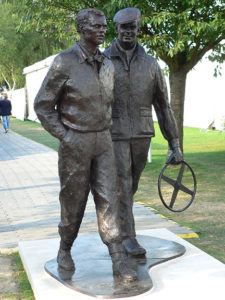
Statue of Lofty England
and Mike Hawthorn
at Goodwood
Lofty became great friends with Mike Hawthorn while he drove for Jaguar Cars and Mike was guest speaker at a Jaguar Apprentices’ function at the end of 1956, at which he was presented with a D-type steering wheel by Lofty. Mike Hawthorn died in a road accident on the A3 Guildford bypass in 1959.
Ten years after Lofty’s death a sculpture was unveiled at Goodwood, of both of them together, with Lofty carrying a D-type steering wheel. This was the work of Sculptor David Annard and was unveiled on 17 September 2005. It cost around £70,000 which had been raised by private subscription. Jaguar Cars had supplied an X-Type which was raffled off, the money going into the fund.
Inscribed on plinth, side 1: MAY THEIR NAME LIVE FOREVER. David Annand Sculptor
Inscribed on plinth, side 2: Mike Hawthorn 1929 – 1959 ‘Lofty’ England 1911 – 1995
First British World Champion 1958 Jaguar Competition Manager 1949 – 56
Inscribed on plinth, side 3: Supporters R Alcock, J Butterworth, Members of the J.D.C. XK Register, E-type Register, J.L.C, Jaguar Club of Denmark
Inscribed on plinth, side 4: Appeal Benefactors. Ron Lea, John Pearson, Nigel Webb. Benefactors: Jaguar Cars Ltd. Lucas Huni. Ole Sommer. Clive Brandon. The Earl of March.
Author: François Prins
© Text and Images – Jaguar Daimler Heritage Trust
Sources and Further Reading:
-
Sainty, Peter J, An Artist at the Game (Peter J Sainty, 2011)
-
Parker, Chas and Porter, Philip, Jaguar C-Type: The Autobiography of XKC 051 (Porter Press International Ltd, 2017)
-
Porter, Philip and Page, James, Jaguar Lightweight E-Type: The Autobiography of 49 FXN (Porter Press International, 2017)
-
Roe, Geoff, Bert Hadley A Son of Birmingham: A Tribute (The Pre-War Austin Seven Club Ltd, 2013)
-
Harvey, Chris, E Type: End of an Era (The Oxford Illustrated Press 1977)
-
Grimsdale, Peter, High Performance: When Britain Ruled the Roads (Simon & Schuster UK, 2020)
-
Lord Montagu of Beaulieu and foreword by HRH Prince Michael of Kent, Jaguar (Quiller Press, 1997)
-
Mennem, Patrick, Jaguar: An Illustrated History (The Crowood Press Ltd, 1991)
-
Parker, Chas, Jaguar D-Type: Owners’ Workshop Manual – 1954 Onwards (All Models) (Haynes Publishing, 2017)
-
Elmgreen, John, Jaguar D-Type: The Story of XKD 526 (Porter Press, 2020)
-
Whyte, Andrew, Jaguar: The Definitive History of a Great British Car (Patrick Stephens Limited, 1990)
-
Daniels, Jeff, Jaguar: The Engineering Story (J H Haynes & Co Ltd, 2004)
-
Porter, Philip, Jaguar: E-Type The Definitive History (Porter Press International, 2015)
-
Martin, Brian James, Jaguar: From the Shop Floor (Veloce Publishing Ltd, 2018)
-
Thorley, Nigel, Jaguar in Coventry: Building the Legend (Breedon Books Publishing Co Ltd, 2013)
-
Berry, Robert, Jaguar: Motor Racing and the Manufacturer (Distributed by E.P. Dutton, 1978)
-
Porter, Philip, Jaguar: Sports Racing Cars (Bay View Books, 1995)
-
Skilleter, Paul, Jaguar: The Sporting Heritage (Virgin Publishing, 2001)
-
Skilleter, Paul, Norman Dewis of Jaguar: Developing the Legend (PJ Publishing Ltd, 2017)
-
Porter, Philip and Skilleter, Paul, Sir William Lyons: The Official Biography (Haynes Publishing, 2001)
-
Edwards, Robert, Stirling Moss: The Authorised Biography (Cassell & Company, 2001)
-
Porter, Philip, Stirling Moss: The Definitive Biography – Volume 1 (Porter Press International, 2016)
-
Bingham, Phillip, The All-American Hero and Jaguar’s Racing E-types (Porter Press International, 2020)
-
Porter, Philip, The Most Famous Car in the World: The Story of the First E-type Jaguar (Cassell, 2000)
-
Wilson, Peter D., XJ13: The Definitive Story of the Jaguar Le Mans Car and the V12 Engine That Powered It (PJ Publishing, 2011)